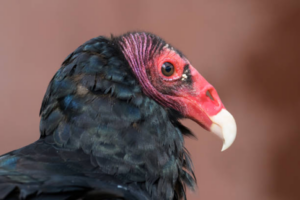The migratory patterns of turkey vultures
Jennifer Tran
When Michael Smith gets into his police car every morning in Bunn, North Carolina, large, dark birds with distinguishably pink heads often await him on the road. “I have to drive slow so I don’t hit them,” Smith said.
Turkey vultures have been gathering in small, rural towns like Bunn in Franklin County. The Federal Migratory Bird Treaty Act protects the birds and prohibits the killing, capturing, selling, trading and transporting of these species without authorization. But these birds can cause property damage.
When roosting on homes, vultures can pull off shingles, caulking around windows and vinyl sliding, according to the North Carolina Wildlife Resources Commission. They can also scratch paint, pull off windshield wipers and crack car windows.
With turkey vultures perching on buildings, the Town of Bunn tried to disperse the birds using automated propane cannon fire during December 2020. The cannon was installed on the roof of the gymnasium of Bunn High School and has since been removed.
“We also have an electrical current going through the radio tower at the high school so the birds don’t sit up there,” Smith said.
Loss of natural habitat
It’s unclear why turkey vultures gather in rural towns. Sunny Cooper, interim medical manager at the Carolina Raptor Center, said the birds are sociable animals, and they may treat small towns as central meeting locations. Deforestation has disrupted vulture habitats and may have pushed the birds into closer human contact. The birds are hard to miss in small towns, but larger towns may have several roosts spread throughout a larger area that escape attention.
With disappearing natural habitats, vultures have taken advantage of human-made structures like roofs and water towers. Increased human movement also means more roadkill, so these birds have an incentive to stay around people.
“They’re very opportunistic with their food, and so if there’s a good congregating spot that’s close to a number of food sources, that’s advantageous for them,” said Jennifer Tyrrell, engagement manager for Audubon South Carolina.

Photo from Unsplash.
Climate change also contributes to turkey vulture movement. Most turkey vultures in North Carolina complete their life cycles in North America, with migration to warmer areas during the winter and cooler areas further north in the summer. As climate change has led to warming of northern lattitudes, the vultures have occupied habitats further north.
“Probably at the turn of the century, they were probably mostly in the southeastern states where they kind of held on the longest,” said John Stanton, supervisory wildlife biologist for the U.S. Fish and Wildlife Service. “A lot of bird populations at the turn of the century declined, but turkey vultures have been making a pretty remarkable comeback in the last 20 to 30 years. They’re recolonizing a lot of the areas they probably were present in pre-European settlement.”
To map the distribution and abundance of birds in North Carolina, the N.C. Wildlife Resources Commission has lanuched a Bird Atlas. John Carpenter, a biologist at the North Carolina Wildlife Resources Commission, said the project will continue for at least four years. At the end of that time biologists will have a better idea of where turkey vultures are breeding and migrating.
